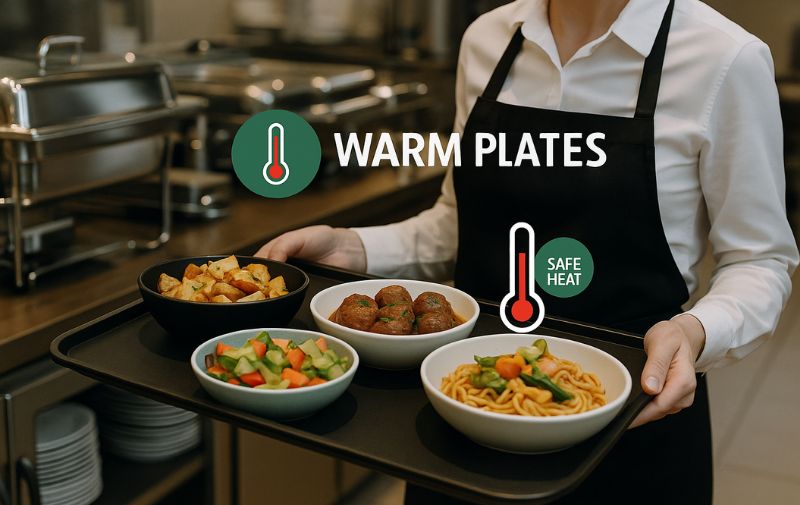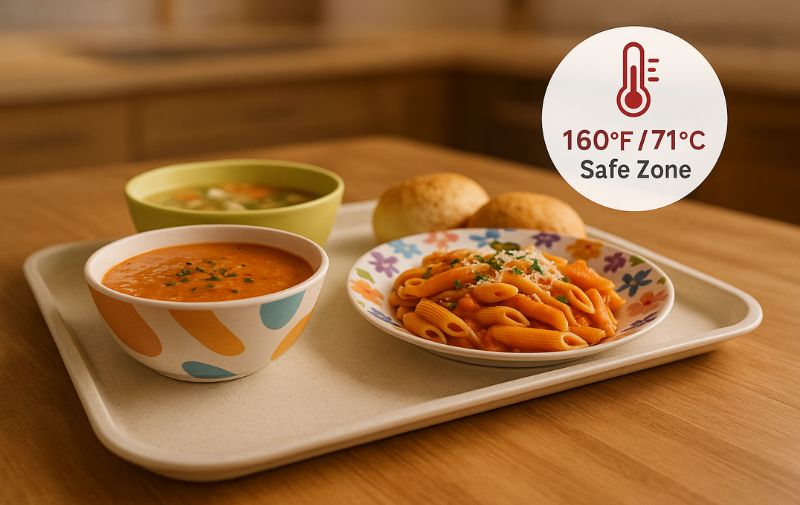Wondering if your melamine trays are heat resistant enough for that steaming hot dish? It’s a common question! While melamine can handle hot food, there’s a melamine temperature limit to be aware of. Exceeding this can lead to warping or even chemical leaching.
This guide clarifies what “heat resistant” truly means for melamine trays, helping you use them safely and confidently for serving hot food on melamine tray surfaces.
Last Updated: May 2025 | Estimated Reading Time: 6 minutes
What Does “Heat Resistant” Mean for Melamine Trays?
When we talk about melamine trays heat resistant properties, it’s a qualified term.
Are melamine trays generally designed to handle hot food items?
Yes, melamine trays are generally designed to handle both hot and cold food items for typical serving durations. They won’t immediately melt or deform when freshly cooked, hot food is placed on them.
- This means you can confidently use them to carry plates of hot meals from the kitchen or serve warm appetizers.
- Industry Insider Tip: The term “heat resistant” in this context means it withstands the heat of served food, not cooking heat.

What is the typical maximum safe temperature melamine trays can endure before potential issues arise?
The generally accepted maximum safe continuous temperature for high-quality A5 melamine is around 160°F (71°C). Some sources might indicate slightly higher transient temperatures are tolerable.
- This is a crucial melamine temperature limit to keep in mind. While food cools rapidly once removed from direct heat, sustained temperatures above this could pose risks.
- Technical Detail: Exceeding this limit, for example with melamine and boiling water (212°F/100°C) in prolonged direct contact, goes beyond this safety threshold, primarily because high heat can accelerate potential chemical leaching.
What Happens if Melamine Trays Exceed Their Safe Temperature Limit?
Pushing melamine beyond its heat tolerance can lead to several problems.
Can high temperatures cause melamine trays to warp or lose their shape?
Yes, exposure to temperatures significantly above their safe limit can cause melamine trays to warp, blister, or lose their original shape over time.
- For you: This compromises the tray’s functionality and appearance.
- Insider Tip: This damage is often cumulative. A few instances of minor overheating might not show immediate effects, but repeated exposure will shorten the tray’s lifespan.
Why does exposure to excessive heat increase the risk of chemical leaching from melamine?
Excessive heat can accelerate the breakdown of the melamine resin, potentially increasing the migration (leaching) of its chemical components, like melamine and formaldehyde, into food or onto the tray surface.
- This is the primary safety concern with overheating melamine. Sticking to temperature guidelines is key to minimizing any melamine leaching heat-related risks. This is why understanding can melamine withstand heat properly is vital.
Is it true that boiling water (212°F/100°C) is above the safe threshold for melamine?
Yes, for prolonged direct contact, boiling water is above the generally recommended continuous safe temperature limit for melamine (around 71°C/160°F).
- For you: Briefly rinsing with hot water or a quick dishwasher cycle (which often uses hot water) is generally fine. However, you shouldn’t let melamine trays soak in boiling water or use them to hold boiling liquids for extended periods.
- Industry Perspective: Food taken directly from a pan and placed on a tray cools rapidly (often to 60-80°C or 140-176°F in seconds). It’s generally considered safe for durable melamine trays to hold food at higher initial temperatures for limited serving durations. The tray isn’t being cooked.
📊 Melamine Tray Overheating Consequences 📊
| Consequence | Description | Your Impact 😟 | Prevention Tip ✅ |
|---|---|---|---|
| 🔥 Warping/Blistering | Tray loses its flat shape, may develop bubbles. | Unstable surface, looks bad, harder to clean. | Adhere to melamine temperature limit (160°F/71°C). |
| 🧪 Increased Leaching | Higher risk of chemicals migrating from the tray. | Potential health concern if limits are significantly exceeded. | NEVER microwave; avoid direct/prolonged extreme heat. |
| ✨ Surface Degradation | Loss of gloss, chalky surface, becomes brittle over time. | Reduced lifespan, less appealing, harder to sanitize. | Avoid abrasive cleaners & repeated overheating. |
| 📉 Structural Weakness | Material integrity compromised, may crack more easily. | Tray becomes less durable and potentially unsafe. | Handle with care, avoid extreme temperature shocks. |
How Does Melamine’s Heat Tolerance Compare to Other Tray Materials? 🤔
Different materials have different strengths when it comes to heat.
Are materials like stoneware generally more heat resistant than melamine for high-temperature applications?
Yes, materials like stoneware, ceramic, glass, and stainless steel are generally much more heat resistant than melamine, especially for high-temperature applications like oven use or direct heat exposure.
- If you need a tray for baking, broiling, or something that will be exposed to very high, sustained temperatures, these other materials are the appropriate choice. Melamine’s strength lies in serving, not cooking.
- Comparison:
- Melamine: Good for serving hot food (up to ~160°F/71°C). Not for ovens/microwaves.
- Stoneware/Ceramic: Can often go in ovens (check manufacturer specs).
- Glass (borosilicate): Excellent for oven use.
- Stainless Steel: Handles very high heat, used in professional kitchens.

What Are the Recommended Guidelines for Using Melamine Trays with Heat?
Following guidelines ensures longevity and safety.
Should melamine trays be used under direct heat sources like ovens or broilers?
Absolutely NOT. Melamine trays are NOT designed for use in conventional ovens, microwave ovens, on stovetops, or under broilers/salamanders.
- his is the most critical rule. Using melamine in these appliances will damage the tray and can make it unsafe.
- Industry Pain Point: Microwaving is the most common misuse. Melamine absorbs microwave energy, overheats, and degrades. This isn’t about its “heat resistance” to served food; it’s total incompatibility with that heating method.
Are there specific recommendations for foodservice operators regarding melamine and heat exposure, such as under heat lamps?
Yes, foodservice operators should be cautious with melamine trays under heat lamp situations.
- Short Duration/Moderate Heat: If heat lamps are used to keep plated food warm for short periods before serving, and the lamp isn’t excessively hot or close, it might be acceptable. The tray surface temperature should not exceed the 160°F/71°C limit.
- Prolonged/Intense Heat: Prolonged exposure to high-intensity heat lamps can overheat the melamine, leading to the issues described above. It’s better to use heat lamps on the food itself (on ceramic/metal plates) rather than directly intensely heating the melamine tray holding those plates.
- Supplier Know-How (e.g., Duramela): Experienced suppliers offer various designs like rectangle trays or plates made from A5 grade melamine designed to handle typical hot and cold food serving temperatures. They can advise on best practices.
How can adhering to temperature guidelines minimize risks associated with melamine trays?
Adhering to temperature guidelines is the single most effective way to:
- Ensure Safety: Minimizes the risk of chemical migration.
- Preserve Integrity: Prevents warping, blistering, and degradation.
- Extend Lifespan: Helps your durable melamine trays last longer.
- For you: Knowing and respecting the melamine safe temperature protects your investment and health. Quality A5 grade melamine will have better thermal stability within its range.
📊 Melamine Tray Heat Usage DOs and DON’Ts 📊
| Action | DO ✅ / DON’T 🚫 | Why? |
|---|---|---|
| Serving freshly cooked, hot meals | ✅ DO | Designed for this; food cools, tray temperature stays within safe limits. |
| Carrying hot plates/bowls | ✅ DO | Ideal use case; facilitates easy and safe transport. |
| Placing under moderate heat lamps (short term) | 🤔 CAUTION | Monitor tray temp; avoid exceeding 160°F/71°C. Prefer heating food directly. |
| Using in a microwave oven | 🚫 DON’T | Damages tray, significantly increases melamine leaching heat risk. 🚨 |
| Using in a conventional oven/broiler | 🚫 DON’T | Not designed for cooking heat; will melt/warp/degrade. |
| Placing scorching hot pans directly on tray | 🚫 DON’T | Extreme direct heat can cause localized damage. |
| Soaking in boiling water for extended periods | 🚫 DON’T | Can exceed safe temperature limits and stress the material. |
| Stacking tightly when very hot & wet (commercial) | 🤔 CAUTION | Allow brief cooling to prevent sticking/minor warping in some designs. |
So, Can You Confidently Use Melamine Trays for Hot Items? 🍽️
Yes, with the right understanding and practices!
For what types of hot food service are melamine trays ideally suited, considering their heat limits?
Melamine trays are excellent for:
- Carrying hot plates of food from the kitchen to tables (e.g., restaurant service, room service).
- Serving items on buffet lines (where food is typically in chafing dishes, not directly heating the tray to extremes).
- Holding warm baked goods (cookies, muffins) once they’ve cooled slightly from oven temperatures.
- Serving hot appetizers or individual hot dishes.
- Cafeteria-style service, where the tray holds various hot and cold items.
- Application Scenario: Think of a cafeteria tray holding a hot main course plate, a bowl of soup, and a warm roll. The tray itself facilitates easy carrying and stays relatively cool.

When might you need to choose an alternative material for serving or holding very hot items?
You should choose an alternative material (like ceramic, glass, or stainless steel) when:
- The item will be placed in an oven, microwave, or under a broiler.
- The item needs to withstand temperatures well above 160°F (71°C) for prolonged periods.
- You are serving directly from a sizzling hot pan where oil temperatures might be extreme.
- You need oven-to-table service.
📊 Melamine Tray vs. Alternatives for Heat 📊
| Task / Need | Melamine Tray (A5 Grade) Suitable? | Better Alternative(s) | Key Reason |
|---|---|---|---|
| Serving plated hot meal (e.g., pasta, stir-fry) | ✅ Yes | N/A (Good for this) | Within melamine safe temperature for serving. |
| Carrying hot coffee mugs & pastry | ✅ Yes | N/A (Good for this) | Ideal use case. |
| Buffet line (food in chafing dishes) | ✅ Yes | N/A (Good for this) | Tray isn’t directly heated to extreme temps. |
| ♨️ Holding food under intense/prolonged heat lamp | 🤔 No (or with extreme caution) | Stainless steel, ceramic | Risk of exceeding melamine temperature limit. |
| 🔥 Baking a casserole in the oven | 🚫 No | Glass, stoneware, metal | Melamine is NOT oven-safe. |
| ♨️ Microwaving leftovers on the tray | 🚫 No | Microwave-safe glass or ceramic | Melamine is NOT microwave-safe. |
| 🍳 Serving sizzling fajitas direct from skillet | 🤔 No | Cast iron serving skillet, wooden underliner | Direct extreme heat can damage melamine. |
Common Questions About Melamine Tray Heat Resistance {#faq}
Q1: Can all types of melamine trays handle the same amount of heat?
No. Higher quality A5 melamine (100% food-grade melamine resin) generally has better thermal stability within its specified range compared to lower grades (A1, A3) or melamine with excessive fillers. Always opt for A5.
Q2: If my melamine tray feels warm with hot food, is that okay?
Yes, it’s normal for the tray to feel warm. Melamine is an insulator to some degree. The concern is if the tray itself becomes excessively hot (approaching or exceeding 160°F/71°C), which is unlikely from just holding a plate of hot food for a normal serving period.
Q3: Does the color of the melamine tray affect its heat resistance?
Generally, no. The chemical composition (ideally A5 grade) and thickness are more critical factors than color for heat resistance within melamine’s normal operating range.
Q4: What are some safe serving trays for hot food besides melamine?
For serving (not cooking), options include wood (often with a food-safe finish), higher-end plastics specifically rated for higher temperatures (polycarbonate, for example, but check specs), and of course, standard plates made of ceramic or glass placed on any type of carrying tray.
Summary: Respect the Heat, Use with Confidence
The heat resistance of melamine makes it a practical and durable melamine tray choice for many foodservice and home applications. The key is understanding its limits:
- Melamine trays are great for serving and carrying hot food on melamine tray surfaces, provided the tray temperature itself doesn’t continuously exceed approximately 160°F (71°C).
- Crucially, melamine is NOT for ovens, microwaves, or direct high-heat cooking sources.
- Always choose A5 grade melamine for the best performance and safety.
By following these guidelines, you can confidently use melamine trays, appreciating their benefits while ensuring they last long and remain safe.
Recommended Internal & External Links:
- Are Melamine Plates & Trays Microwave Safe? The Definitive Answer
- FDA – Melamine in Tableware: Questions and Answers (Addresses safe use, including temperature considerations)



